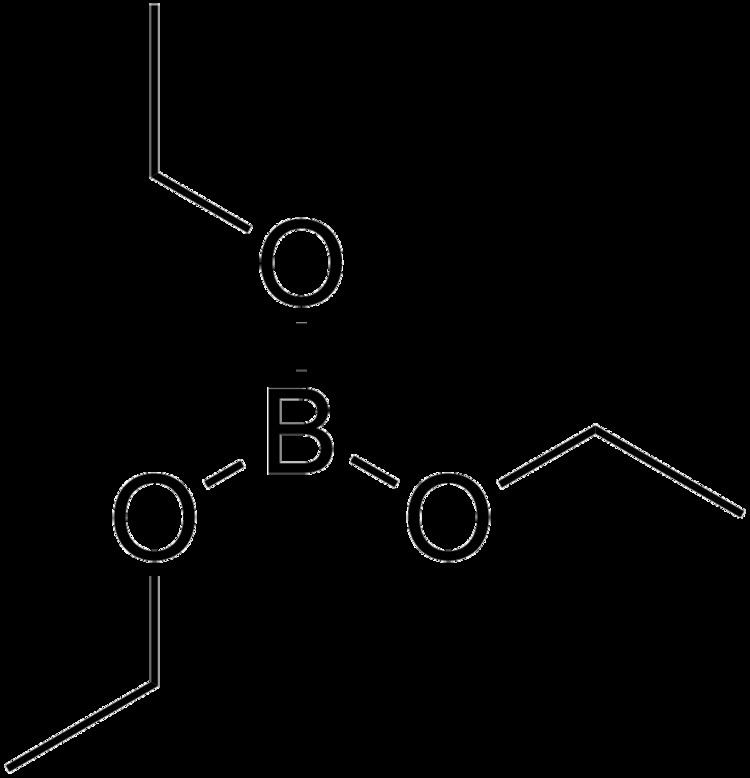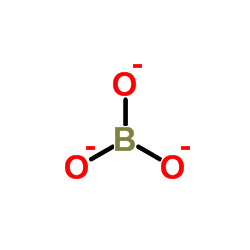 | ||
Borate
Borates are the name for a large number of boron-containing oxyanions. The term "borates" may also refer to tetrahedral boron anions, or more loosely to chemical compounds which contain borate anions of either description. Larger borates are composed of trigonal planar BO3 or tetrahedral BO4 structural units, joined together via shared oxygen atoms and may be cyclic or linear in structure. Boron most often occurs in nature as borates, such as borate minerals and borosilicates.
Contents

Structures

The simplest borate anion, the orthoborate ion, BO3−
3 is known in the solid state, for example in Ca3(BO3)2. In this it adopts a near trigonal planar structure. It is a structural analogue of the carbonate anion CO2−
3, with which it is isoelectronic. Simple bonding theories point to the trigonal planar structure. In terms of valence bond theory the bonds are formed by using sp2 hybrid orbitals on boron. Some compounds termed orthoborates do not necessarily contain the trigonal planar ion, for example gadolinium orthoborate, GdBO3 contains the polyborate B
3O9−
9 ion, whereas the high temperature form contains planar BO3−
3.
Boric acid

All borates can be considered derivatives of boric acid, B(OH)3. Boric acid is a weak proton donor (pKa ~ 9) in the sense of Brønsted acid, but is a Lewis acid, i.e., it can accept an electron pair. In water, it behaves as a Lewis acid accepting the electron pair of a hydroxyl ion produced by the water autoprotolysis.
So, B(OH)3 is acidic because of its reaction with OH– from water, forming the tetrahydroxyborate complex (B(OH)–
4) and releasing the corresponding proton left by the water autoprotolysis:
4 + H3O+ (pKa = 8.98)
In the presence of cis-diols such as mannitol, glucose, sorbitol and glycerol the pKa is lowered to about 4.
Polymeric ions
Under acid conditions boric acid undergoes condensation reactions to form polymeric oxyanions:
4 B(OH)−4 + 2 H+ ⇌ B
4O
5(OH)2−
4 + 7 H2O
The tetraborate anion (tetramer) includes two tetrahedral and two trigonal boron atoms symmetrically assembled in cyclic structure. The two tetrahedral boron atoms are linked together by a common oxygen atom and each also bears a negative net charge brought by the supplementary OH− groups laterally attached to them. This intricate molecular anion also exhibits three rings: two distorted hexagonal rings and one distorted octagonal ring. Each ring is made of a succession of alternate boron and oxygen atoms.
The tetraborate anion occurs in the mineral borax, as an octahydrate, Na2B4O5(OH)4·8H2O. The borax chemical formula is also commonly written in a more compact but equivalent notation as Na2B4O7·10H2O, simply by converting stoichiometrically 4 OH− as 2 O2− and 2 H2O.
Sodium borate can be obtained in high purity and so can be used to make a standard solution in titrimetric analysis.
A number of metal borates are known. They arise by treating boric acid or boron oxides with metal oxides. Examples hereafter include linear chains of 2, 3 or 4 trigonal BO3 structural units, each sharing only one oxygen atom with adjacent unit(s):
2O4−
5, found in Mg2B2O5 (suanite)
3O5−
7, found in CaAlB3O7 (johachidolite)
4O6−
9, found in Li6B4O9
Metaborates, such as LiBO2 contain chains of trigonal BO3 structural units, each sharing two oxygen atoms with adjacent units, whereas NaBO2 and KBO2 contain the cyclic B
3O2−
6 ion.
Borosilicates
Borosilicate glass, also known as pyrex, can be viewed as a silicate in which some SiO4−
4 units are replaced by BO5−
4 centers, together with a cation to compensate for the difference in valence states of Si(IV) and B(III). Because of this substitution leads to imperfections, the material is slow to crystallise and forms a glass with low coefficient of thermal expansion and is resistant to cracking when heated, unlike soda glass.
Minerals and uses
Common borate salts include sodium metaborate, NaBO2, and borax. Borax is soluble in water, so mineral deposits only occur in places with very low rainfall. Extensive deposits were found in Death Valley and transported out using the famous twenty-mule teams (1883 to 1889). Later (1925), deposits were found at Boron, California on the edge of the Mojave Desert. The Atacama Desert in Chile also contains mineable borate concentrations.
Lithium metaborate or lithium tetraborate, or a mixture of both, can be used in borate fusion sample preparation of various samples for analysis by XRF, AAS, ICP-OES, ICP-AES and ICP-MS. Borate fusion and energy dispersive X-ray fluorescence spectrometry with polarized excitation have been used in the analysis of contaminated soils.
Disodium octaborate tetrahydrate is used as wood preservatives or fungicide. Zinc borate is used as a flame retardant.
Borate esters
Borate esters are organic compounds of the type B(OR)3 where R is alkyl or aryl. They are conveniently prepared by condensation reaction of boric acid and the alcohol:
B(OH)3 + 3 ROH → B(OR)3 +3 H2OA dehydrating agent, such as concentrated sulfuric acid is typically added. Borate esters are volatile and can be purified by distillation. This procedure is used for analysis of trace amounts of borate and for analysis of boron in steel. Like all boron compounds, alkyl borates burn with a characteristic green flame. This property is used to determine the presence of boron in qualitative analysis.
Borate esters form more spontaneously when treated with diols such as sugars.
Trimethyl borate, B(OCH3)3, is used as a precursor to boronic esters for Suzuki couplings: Unsymmetrical borate esters are prepared from alkylation of trimethyl borate:
ArMgBr + B(OCH3)3 → MgBrOCH3 + ArB(OCH3)2ArB(OCH3)2 + 2 H2O → ArB(OH)2 + 2 HOCH3These esters hydrolyze to boronic acids, which are used in Suzuki couplings.
